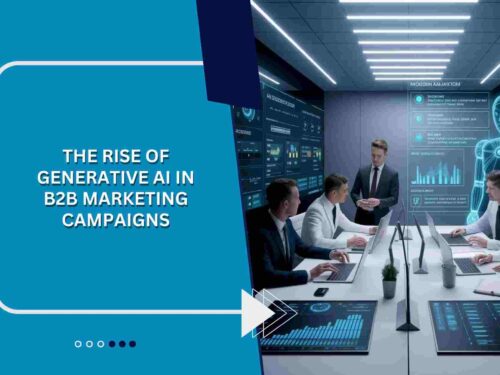The landscape of B2B marketing is evolving faster than ever, driven by digital acceleration, AI-powered automation, and data-first strategies. In this dynamic environment, performance marketing has emerged as a cornerstone of measurable, ROI-focused B2B growth. Unlike traditional brand-centric approaches, performance marketing ensures that every dollar spent delivers quantifiable results be it leads, conversions, or revenue.
As 2025 unfolds, B2B businesses are under increasing pressure to optimize marketing spend, prove ROI, and accelerate sales cycles. That’s where performance marketing steps in offering the precision, scalability, and transparency that today’s B2B marketers demand. Whether you’re launching account-based campaigns or scaling demand generation, understanding the nuances of performance marketing is key to staying competitive.
This guide explores everything you need to know about B2B performance marketing in 2025 from strategic frameworks and data activation to personalization tactics and martech stacks built for impact.
What Is B2B Performance Marketing?
At its core, performance marketing is a digital marketing strategy that ties success to clearly defined actions. These can include lead generation, content downloads, webinar signups, or product demos. In B2B environments, where sales cycles are long and decision-making involves multiple stakeholders, this results-driven model enables marketers to align efforts closely with business outcomes.
Unlike traditional methods that focus on awareness or impressions, performance marketing prioritizes conversions and cost-efficiency. Budgets are allocated based on how well campaigns perform, and marketers can adjust strategies in real-time to optimize impact.
In 2025, B2B performance marketing is powered by AI, intent data, and advanced analytics enabling personalized experiences at scale while maintaining full visibility into ROI.
Why B2B Performance Marketing Matters in 2025
Several macro trends are fueling the rise of performance marketing in B2B:
- Increased Budget Scrutiny: CFOs and CMOs are demanding proof of ROI. With budgets tightening, every marketing dollar must deliver measurable outcomes.
- AI and Automation: Tools now allow for intelligent targeting, predictive scoring, and real-time optimization making performance marketing faster and more effective.
- Data Democratization: Access to first-party, second-party, and intent data helps B2B marketers understand buyer behavior and personalize campaigns more effectively.
- Sales-Marketing Alignment: Performance-driven strategies enable tighter collaboration between sales and marketing teams, streamlining lead qualification and pipeline growth.
In 2025, B2B companies that don’t integrate performance marketing into their strategy risk losing ground to competitors who are already leveraging data to outmaneuver and outperform.
Key Components of a B2B Performance Marketing Strategy
1. Goal-Oriented Campaign Planning
Every performance marketing initiative starts with crystal-clear objectives. Whether it’s increasing MQLs (Marketing Qualified Leads), boosting demo bookings, or driving enterprise pipeline, goal alignment ensures that every tactic has a measurable KPI.
In 2025, successful B2B marketers are using SMART goals (Specific, Measurable, Achievable, Relevant, Time-bound) to guide their campaign planning. These goals are tied directly to business outcomes and are updated regularly based on evolving performance metrics.
2. Channel Selection Based on ROI
Unlike brand campaigns that cast a wide net, performance marketing relies on selecting high-performing channels. The top B2B performance marketing channels in 2025 include:
- Programmatic Display Ads: Delivering targeted content to high-intent users based on behavioral and firmographic data.
- LinkedIn Ads: Ideal for account-based marketing (ABM) and lead gen targeting by job title, industry, and seniority.
- Google Search Ads: Capturing demand at the bottom of the funnel.
- Content Syndication: Partnering with B2B networks to distribute gated assets to intent-rich audiences.
- Email Marketing: Hyper-personalized, behavior-triggered sequences that nurture leads efficiently.
Marketers continually assess channel performance using CPA (Cost per Acquisition), CPL (Cost per Lead), and ROAS (Return on Ad Spend) to shift budget toward what’s working.
3. Intent Data and Audience Targeting
Audience targeting has evolved beyond firmographics and demographics. In 2025, performance marketing campaigns are driven by intent data digital signals that indicate a buyer’s readiness to engage.
Platforms like Bombora, ZoomInfo, and G2 provide rich intent data that helps marketers identify in-market accounts. These insights are used to:
- Trigger outbound email campaigns.
- Prioritize ABM outreach.
- Customize ad creatives based on buying stage.
The use of AI-powered segmentation allows for precision targeting at scale ensuring your message lands with the right decision-makers at the right time.
4. Conversion-Optimized Content and CTAs
Content still reigns in B2B, but in performance marketing, every piece must be optimized for conversion. In 2025, high-performing content formats include:
- Interactive Assessments: Tools that deliver value while capturing data.
- Gated Whitepapers & Case Studies: Strategically placed on high-intent landing pages.
- On-Demand Webinars: Easily scalable and highly effective at lead capture.
Strong CTAs such as “Book a Demo,” “Download Now,” or “Talk to Sales” are placed prominently and backed by data-driven A/B testing to maximize conversions.
5. Real-Time Analytics and Reporting
In B2B performance marketing, what gets measured gets improved. In 2025, marketers are using real-time analytics platforms like HubSpot, Salesforce, and GA4 to track every interaction and touchpoint.
Key metrics tracked include:
- Conversion Rate by Channel
- Lead Quality Scores
- Attribution Modeling (First-click, Last-click, Multi-touch)
- Customer Acquisition Cost (CAC)
- Sales Cycle Duration
By leveraging real-time dashboards and predictive analytics, marketers can pivot instantly when performance drops or scale tactics that overperform.
6. Marketing and Sales Alignment
The most effective performance marketing strategies are built in tandem with sales. In 2025, tight alignment ensures that:
- Sales teams follow up on MQLs promptly.
- Feedback loops help refine targeting and messaging.
- Lead scoring systems reflect real-time buyer behavior.
Weekly standups, shared dashboards, and integrated CRMs bridge the gap between marketing-qualified and sales-qualified leads creating a seamless journey for the buyer and a stronger pipeline for sales.
Personalization at Scale: The New Standard
Generic campaigns no longer cut it. B2B buyers in 2025 expect personalized experiences at every touchpoint. Through AI and machine learning, performance marketing now enables real-time personalization at scale:
- Dynamic content adapts based on user behavior and industry.
- Email nurture sequences change based on previous engagement.
- Landing pages are auto-customized to match firmographic attributes.
This personalization significantly increases engagement, click-through rates, and ultimately, conversion.
Role of AI in Performance Marketing
AI is no longer optional it’s foundational to high-performing performance marketing campaigns in 2025. AI powers:
- Predictive lead scoring
- Smart bidding in programmatic campaigns
- Conversational AI for chatbots and sales qualification
- Automated A/B testing
- Forecasting campaign performance
By handling repetitive tasks and offering deep insights, AI allows marketers to focus on strategy and creativity, maximizing campaign output and efficiency.
B2B Performance Marketing Tools & Tech Stack
To execute high-impact performance marketing, B2B teams rely on an integrated martech stack. Key tools include:
- CRM & Automation: HubSpot, Salesforce, Marketo
- Advertising Platforms: LinkedIn Ads, Google Ads, Demandbase
- Analytics & BI: Google Analytics 4, Tableau, Datorama
- Intent Data Platforms: Bombora, 6sense, G2
- ABM Platforms: Terminus, RollWorks, Demandbase
Choosing the right tools and integrating them properly is critical for campaign accuracy, lead nurturing, and attribution.
Compliance and Data Privacy in 2025
With growing concerns around data privacy and stricter regulations like GDPR, CCPA, and India’s DPDP Act, performance marketing in 2025 demands rigorous compliance.
B2B marketers must ensure:
- Consent-based data collection
- Transparent opt-in practices
- Clear privacy policies
- Secure data storage and processing
Trust is currency in B2B, and compliance isn’t just a legal necessity it’s a brand differentiator.
Future Trends in B2B Performance Marketing
Looking ahead, several trends are shaping the future of performance marketing:
- First-Party Data Strategy: As cookies phase out, first-party data will become a key driver of audience insights.
- Voice Search Optimization: B2B buyers are using voice search tools campaigns will be optimized for this format.
- Conversational Marketing: Tools like Drift and ChatGPT-powered bots are enhancing lead capture and qualification.
- Video-Driven Campaigns: Short-form videos and explainers are gaining traction in demand generation strategies.
- Sustainable Marketing: Ethical, eco-conscious branding is influencing campaign messaging and positioning.
Adapting to these trends will ensure that performance marketing remains agile, targeted, and impactful.
Looking to amplify your B2B performance marketing strategy in 2025?
Contact Us at Acceligize for expert-led solutions that drive measurable results and scale your ROI.




